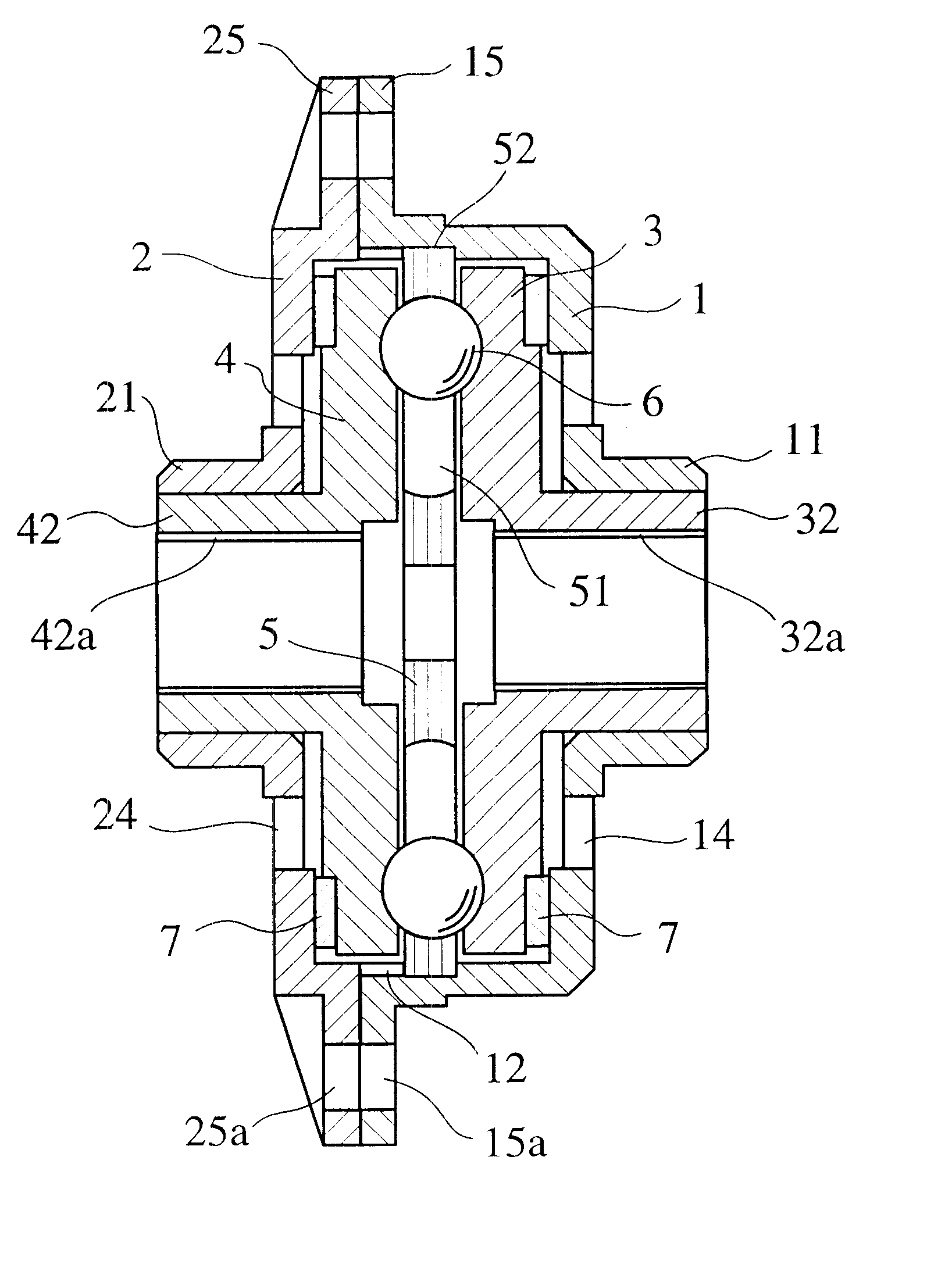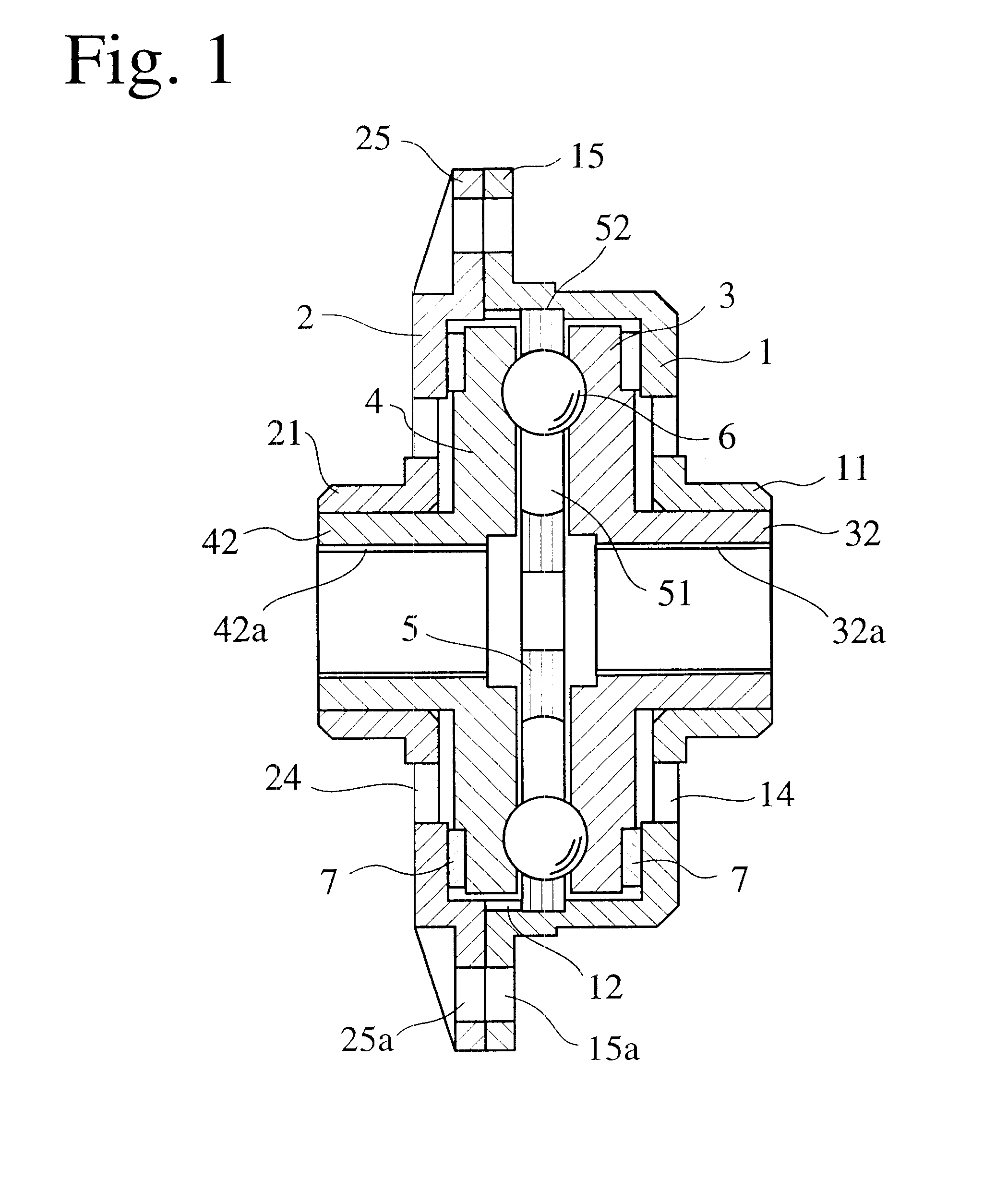Differential device and method of manufacturing the device
a technology of differential devices and manufacturing methods, applied in the direction of differential gearings, mechanical devices, gearings, etc., can solve the problems of loss of driving force, failure to escape, loss of driving force for running on a curve at a high speed,
- Summary
- Abstract
- Description
- Claims
- Application Information
AI Technical Summary
Benefits of technology
Problems solved by technology
Method used
Image
Examples
example 1
Comparative Example 1
With the differential apparatus shown in FIGS. 1-3, a lubrication durability test was carried out. Each steel ball made of JIS SUJ2 had a diameter of 16.00 mm, and a steel-made ball holder 5 having 10 guide holes 51 was 90 mm in diameter and 6 mm in thickness. Each guide hole 51 had a width of 16.0 mm. The disc plates 3, 4, the ball holder 5 and the balls 6 were subjected to a chemical treatment by immersion in a chemical treatment bath containing a phosphate chemical treatment agent (tradename: Ferrycoat 7, available from Japan Parkerizing, Co., Ltd.) at 80.degree. C. for 10 minutes. The chemical treatment coating layer formed on each part had an average thickness of 5 .mu.m.
Each part formed with the chemical treatment coating layer was assembled to a differential apparatus of EXAMPLE 1, and the same differential apparatus as in EXAMPLE 1 except for forming no chemical treatment coating layer was identified as COMPARATIVE EXAMPLE 1. Operation tests were conduct...
example 2
The inner surfaces of the guide holes 51 of the ball holder 5, the surfaces of the balls 6, and the surfaces of the guide grooves 31, 41 of the disc plates 3, 4, which were formed with a chemical treatment coating layer as in EXAMPLE 1. were sprayed with a solid lubricant treatment solution of a molybdenum disulfide-containing, resin-based coating composition (tradename: HMB-2, available from Japan Parkerizing, Co., Ltd.) diluted with an organic solvent, dried at room temperature, and then baked at 200.degree. C. for 60 minutes to form a solid lubricating layer. The solid lubricating layer formed on the chemical treatment coating layer of the guide holes 51 had an average thickness of 10 .mu.m, and the solid lubricating layer formed on the chemical treatment coating layer of the ball 6 had an average thickness of 5 .mu.m. Also, the solid lubricating layer formed on the chemical treatment coating layer on the guide grooves 31, 41 of the disc plates 3, 4 had an average thickness of 10...
examples 3 , 4
EXAMPLES 3, 4
With the rolling-forming apparatus shown in FIG. 41, a winding continuous groove of a disc plate for a differential apparatus was worked. A disc plate die 401 used was made of alloyed tool steel (JIS SKS3) having a hardness of HRC 60. Rolling-forming balls 9 each having a diameter of 16.00 mm were made of high-carbon chromium bearing steel (JIS SUJ3) having a hardness of HRC 62 or more. The ball holder 5 having a diameter of 44 mm and a thickness of 5.5 mm was made of chromium-vanadium steel (JIS SUP10) having a hardness of HRB 400.
First, the disc plate precursor 402 was cut to form a winding continuous groove 421 having a U-shaped cross section, such that a rolling-forming margin was about 0.1 mm (EXAMPLE 3), and 0.2 mm (EXAMPLE 4), respectively. Incidentally, portions not contributing to the transmission of force may be provided with recesses or notches. The primarily worked disc plate precursor 402 was assembled as shown in FIG. 41, disposed in a metal case and then ...
PUM
 Login to View More
Login to View More Abstract
Description
Claims
Application Information
 Login to View More
Login to View More - R&D
- Intellectual Property
- Life Sciences
- Materials
- Tech Scout
- Unparalleled Data Quality
- Higher Quality Content
- 60% Fewer Hallucinations
Browse by: Latest US Patents, China's latest patents, Technical Efficacy Thesaurus, Application Domain, Technology Topic, Popular Technical Reports.
© 2025 PatSnap. All rights reserved.Legal|Privacy policy|Modern Slavery Act Transparency Statement|Sitemap|About US| Contact US: help@patsnap.com



